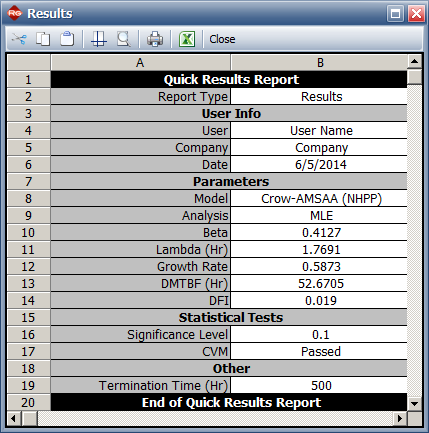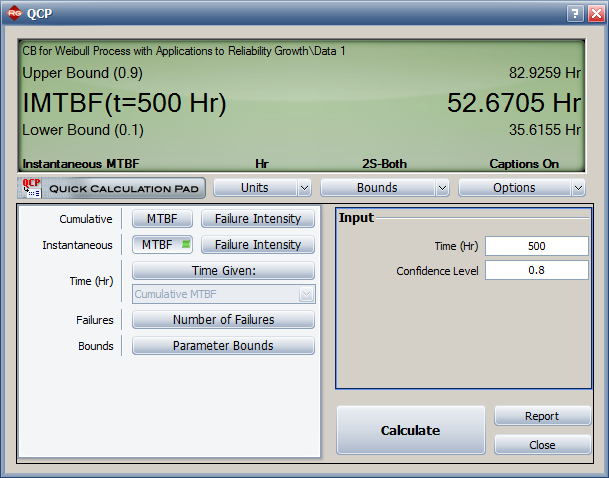New format available! This reference is now available in a new format that offers faster page load, improved display for calculations and images and more targeted search.
As of January 2024, this Reliawiki page will not continue to be updated. Please update all links and bookmarks to the latest references at RGA examples and RGA reference examples.
This example compares the results for test-fix-test data (time terminated).
Reference Case
Crow, L.H., Confidence Interval Procedures for the Weibull Process with Applications to Reliability Growth, U.S. Army Material Systems Analysis Activity, 1981.
For this example, the following will be calculated:
- Parameters of the Crow-AMSAA (NHPP) model
- Demonstrated MTBF (DMTBF)
- 80% two-sided confidence bounds on the DMTBF
Data
The following table shows the data.
| 0.2
|
| 4.2
|
| 4.5
|
| 5
|
| 5.4
|
| 6.1
|
| 7.9
|
| 14.8
|
| 19.2
|
| 48.6
|
| 85.8
|
| 108.9
|
| 127.2
|
| 129.8
|
| 150.1
|
| 159.7
|
| 227.4
|
| 244.7
|
| 262.7
|
| 315.3
|
| 329.6
|
| 404.3
|
| 486.2
|
Termination Time = 500 hours
Result
The book has the following results:
- Beta = 0.413, Lambda = 1.769
- Confidence Bounds on DMTBF (CL = 80%) = (35.6, 82.9)
Results in RGA
In RGA, the Crow-AMSAA (NHPP) model with the maximum likelihood estimation (MLE) method was used to calculate the results. The following equations are used to calculate [math]\displaystyle{ \beta\,\! }[/math] and [math]\displaystyle{ \lambda\,\! }[/math].
- [math]\displaystyle{ \begin{align}
\hat{\beta }=&\frac{N}{N\ln T^{*}-\underset{i=1}{\overset{N}{\mathop \sum }}\,T_{i}}\\
\\
=&\frac{23}{{23\cdot \ln \left ( 500 \right )}-87.2106}\\
\\
=&0.4127
\end{align}\,\! }[/math]
- [math]\displaystyle{ \begin{align}
\hat{\lambda }=&\frac{N}{T^{*\beta }}\\
\\
=&\frac{23}{500^{0.4127}}\\
\\
=&1.7691
\end{align}\,\! }[/math]
- The model parameters are:
- The instantaneous MTBF and its two-sided 80% confidence bounds are:


